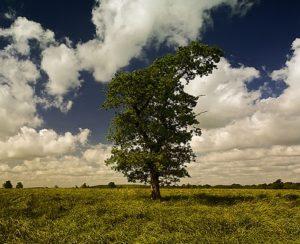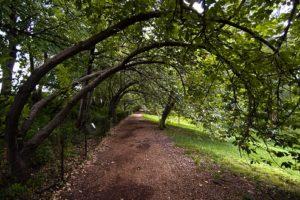Caring for trees in the summer is a little different from the other seasons, and if all things are going well, you’re definitely going to take a more hands-off approach. This doesn’t mean you’re off the hook, though! Healthy trees require attention so that they stay healthy, even when it appears that things couldn’t be better.
Here are five tips to keep your trees healthy during the hot weather. These tips will make sure you have less to do in the fall and winter, too!
Add Some Mulch to Trees in Summer
Mulch, the organic material you spread under plants to protect and nurture the roots, can also protect the tree from the heat. Spread around the base of the tree to a depth of 3 – 4 inches, covering a circle of roughly five feet. This will prevent excessive dehydration of the soil during times of drought, retaining moisture and protecting the roots from temperature extremes.
There is a correct way to spread the mulch because too much of it too close to the trunk can retain too much moisture. This creates the ideal environment for pests, diseases, and wood decay. Don’t let the mulch touch the trunk, and keep the 3 – 4-inch depth consistent around the tree without letting it pile.
Consistent Watering Is Essential Summer Tree Care
Watering trees is confusing to some people because it seems like nature provides enough for these resilient plants to survive. It’s true, watering varies based on the age of the tree:
 New trees: Water immediately after planting, and continue to keep the ground moist. Water deep so the roots grow deep, and in hot, dry conditions, do this three times a week.
New trees: Water immediately after planting, and continue to keep the ground moist. Water deep so the roots grow deep, and in hot, dry conditions, do this three times a week.
For Trees two years old or less: Use mulch and woodchips to retain moisture so that the growing tree doesn’t have to expend a lot of energy searching for water. Water it for roughly 30 seconds with the hose, keeping the soil moist but not soggy.
For Trees two years old and up: Two years is an adequate amount of time to let the tree take root. It will be able to withstand a wider range of water conditions, but you can still provide some water. Provide a deep soak to moisten the soil.
To check when your tree needs water, use a long screwdriver; if it can’t break the soil past six inches, give the tree a watering. Don’t overwater, though, because too much moisture on the trunk can cause rot.
Check Regularly For Pests To Care For Trees On Your Property
 Your tree might look healthy and strong, but it could be attracting pests, and the effects of these might not show until it’s too late. Take a close look at your tree every week or so, keeping an eye out for cleanly bored holes, wounds in the bark, dripping sap, and dying or dead branches. These could all be signs of larval infestations that are disrupting the uptake of water throughout the tree’s system.
Your tree might look healthy and strong, but it could be attracting pests, and the effects of these might not show until it’s too late. Take a close look at your tree every week or so, keeping an eye out for cleanly bored holes, wounds in the bark, dripping sap, and dying or dead branches. These could all be signs of larval infestations that are disrupting the uptake of water throughout the tree’s system.
Checking for pests is not just good for your trees; it can be good for the trees in your neighbourhood, too! If you find a pest like the Emerald Ash Borer on your property, handling it right away can prevent a localized infestation, saving trees and stopping the bugs from spreading further.
Prune Trees In Summer Only When Necessary
While pruning is best done when the tree is dormant, you can prune smartly in the summer, too. Usually, it should only be done for corrective reasons, preventing certain limbs from sapping energy away from the healthy parts of the tree. Defective, dead, and dying limbs should be pruned ASAP before whatever is killing or has killed the limb spreads to the rest of the canopy, trunk, or tree in general.
Pruning can help the tree grow healthier by opening up the canopy to improve the circulation of air and reducing the amount of water the tree needs, as most of the water is used by leaves. For the most effective job, this type of pruning should be done by professionals who can discern what limbs should stay and what can go.
Summer Tree Care Means Improving Your Soil
One final tip for summer tree care is improving the soil in which your tree sits. Hard, compact soil has little moisture and oxygen from which the tree can pull what it needs. Aerating and de-compacting increase the flow of air and water to the roots, providing the tree with what it needs.
Start by getting the soil nice and moist the day before aeration. Using a soil auger (or, if you can’t get one, a drill), make a series of holes two inches apart, starting three feet out from the trunk and going back every two feet until the edge of the canopy. The holes should be two to three inches in diameter and up to 18 inches deep. Fill them loosely with mulch or topsoil, then apply your two to three inches of mulch.
Read our back catalogue if you liked this article and are hungry for more useful tree care tips. And of course, contact us if you have any questions.

